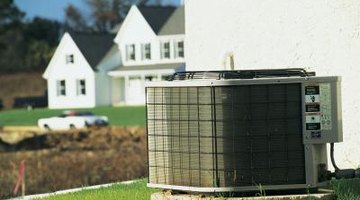Why Do My Lights Dim When the Neighbor's Air Conditioner Goes On?
Air conditioner systems use an electric motor to operate the compressor system within the air conditioning unit as well as an electric fan to circulate air. Electric motors are inductive electrical loads, and often demand more power on startup than while running. It may seem logical that the lights in your home dim a bit when your air conditioner turns on; however, it may seem out of sorts if the lights dim when your neighbor’s air conditioner turns on.
Air Conditioners Require Extra Power at Startup

An electric motor inside an air conditioner requires more energy to start turning than to continue turning. When an electric motor is turned on, the electromotive force generated by the motor coil will oppose the change in voltage that created the force; this phenomenon is called a “back EMF.” A motor that has a load to drive – such as a compressor motor turning the compressor piston – will experience a smaller back EMF than an unloaded motor. Since the effect of a back EMF is still present, a motor will require more electric current – and by extension, more power – at startup than during continuous operation.
Why an Air Conditioner Causes Lights to Dim
An air conditioner that shares a common power circuit with a lamp may cause the lamp to noticeably dim when the air conditioner starts up. Since the motors in an air conditioner require more power to start up than to keep running, the air conditioner may cause the power to “sag” for other devices sharing that circuit. This power sag may come in the form of reduced voltage or current to other devices sharing that circuit. An under-voltage or under-current condition may cause an electric lamp to go dim or to go out completely.
Several Homes May Share One Transformer
Many electric transformers are designed to provide hundreds of amps of electric current at a specified voltage. Since a single-family dwelling may only require a 100-amp or 200-amp electrical service, two or more homes may be connected to a single transformer.
Shared Power Sources
When two or more electric devices share a single power source, the power draw on that power source is equal to the sum of the power being drawn by each individual device. Similarly, when two homes share a single transformer, the total power drawn from the transformer is equal to the sum of the power being drawn by each home. If one home temporarily draws more power than the other – such as during an air conditioner’s startup phase – the second home may experience a power sag and dimming or flickering lights.
References
Writer Bio
David Sandoval has served as a trainer and technical writer since 2000. He has written several articles online in the fields of home improvement, finance, electronics and science. Sandoval has an Associate of Applied Science in microelectronics from Northern New Mexico College.
Photo Credits
- Comstock/Comstock/Getty Images
More Articles



